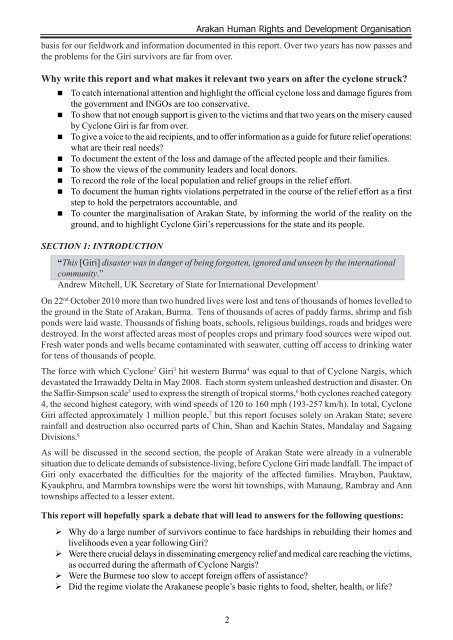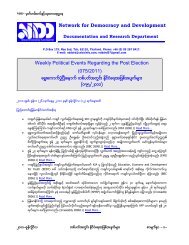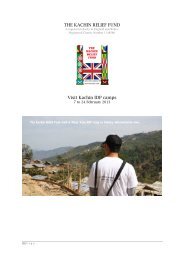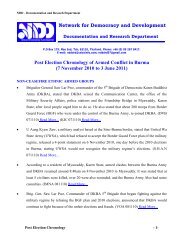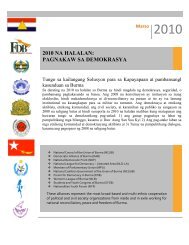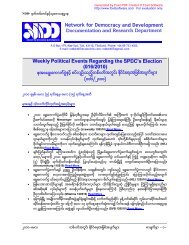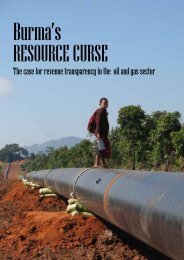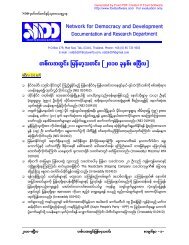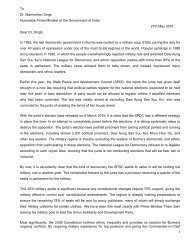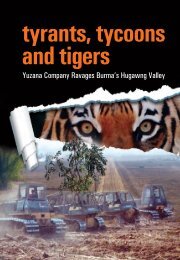Cyclone Giri - Two Years On - Burma Action Ireland
Cyclone Giri - Two Years On - Burma Action Ireland
Cyclone Giri - Two Years On - Burma Action Ireland
You also want an ePaper? Increase the reach of your titles
YUMPU automatically turns print PDFs into web optimized ePapers that Google loves.
Arakan Human Rights and Development Organisation<br />
basis for our fieldwork and information documented in this report. Over two years has now passes and<br />
the problems for the <strong>Giri</strong> survivors are far from over.<br />
Why write this report and what makes it relevant two years on after the cyclone struck<br />
To catch international attention and highlight the official cyclone loss and damage figures from<br />
the government and INGOs are too conservative.<br />
To show that not enough support is given to the victims and that two years on the misery caused<br />
by <strong>Cyclone</strong> <strong>Giri</strong> is far from over.<br />
To give a voice to the aid recipients, and to offer information as a guide for future relief operations:<br />
what are their real needs<br />
To document the extent of the loss and damage of the affected people and their families.<br />
To show the views of the community leaders and local donors.<br />
To record the role of the local population and relief groups in the relief effort.<br />
To document the human rights violations perpetrated in the course of the relief effort as a first<br />
step to hold the perpetrators accountable, and<br />
To counter the marginalisation of Arakan State, by informing the world of the reality on the<br />
ground, and to highlight <strong>Cyclone</strong> <strong>Giri</strong>’s repercussions for the state and its people.<br />
SECTION 1: INTRODUCTION<br />
“This [<strong>Giri</strong>] disaster was in danger of being forgotten, ignored and unseen by the international<br />
community.”<br />
Andrew Mitchell, UK Secretary of State for International Development 1<br />
<strong>On</strong> 22 nd October 2010 more than two hundred lives were lost and tens of thousands of homes levelled to<br />
the ground in the State of Arakan, <strong>Burma</strong>. Tens of thousands of acres of paddy farms, shrimp and fish<br />
ponds were laid waste. Thousands of fishing boats, schools, religious buildings, roads and bridges were<br />
destroyed. In the worst affected areas most of peoples crops and primary food sources were wiped out.<br />
Fresh water ponds and wells became contaminated with seawater, cutting off access to drinking water<br />
for tens of thousands of people.<br />
The force with which <strong>Cyclone</strong> 2 <strong>Giri</strong> 3 hit western <strong>Burma</strong> 4 was equal to that of <strong>Cyclone</strong> Nargis, which<br />
devastated the Irrawaddy Delta in May 2008. Each storm system unleashed destruction and disaster. <strong>On</strong><br />
the Saffir-Simpson scale 5 used to express the strength of tropical storms, 6 both cyclones reached category<br />
4, the second highest category, with wind speeds of 120 to 160 mph (193-257 km/h). In total, <strong>Cyclone</strong><br />
<strong>Giri</strong> affected approximately 1 million people, 7 but this report focuses solely on Arakan State; severe<br />
rainfall and destruction also occurred parts of Chin, Shan and Kachin States, Mandalay and Sagaing<br />
Divisions. 8<br />
As will be discussed in the second section, the people of Arakan State were already in a vulnerable<br />
situation due to delicate demands of subsistence-living, before <strong>Cyclone</strong> <strong>Giri</strong> made landfall. The impact of<br />
<strong>Giri</strong> only exacerbated the difficulties for the majority of the affected families. Mraybon, Pauktaw,<br />
Kyaukphru, and Marmbra townships were the worst hit townships, with Manaung, Rambray and Ann<br />
townships affected to a lesser extent.<br />
This report will hopefully spark a debate that will lead to answers for the following questions:<br />
Why do a large number of survivors continue to face hardships in rebuilding their homes and<br />
livelihoods even a year following <strong>Giri</strong><br />
Were there crucial delays in disseminating emergency relief and medical care reaching the victims,<br />
as occurred during the aftermath of <strong>Cyclone</strong> Nargis<br />
Were the Burmese too slow to accept foreign offers of assistance<br />
Did the regime violate the Arakanese people’s basic rights to food, shelter, health, or life<br />
2


